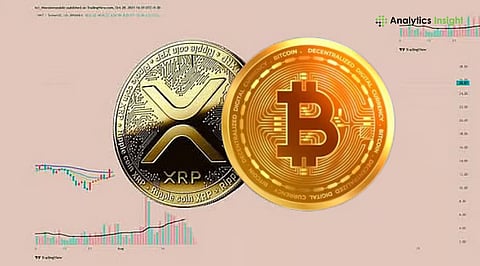

To understand how high XRP must rise to surpass Bitcoin, it is necessary to compare their market capitalisations. Bitcoin recently held a market value of about $1.74 trillion, while XRP has a circulating supply of 60,107,199,237 tokens.
If XRP were to match Bitcoin’s market capitalisation at that level, its price would need to reach around $28.95 per XRP. Bitcoin’s market cap is divided by the number of XRP tokens in circulation. The result shows the price at which XRP would have the same overall value as Bitcoin.
The required price does not stay fixed. Market capitalisation is always shifting as both supply and price change.
If Bitcoin’s market cap rises, the required XRP price also rises. For example, if BTC returned to a higher valuation near $2.4 trillion, XRP would need to climb to almost $39.93 to match that size. If Bitcoin’s value falls, the required XRP price drops as well.
The circulating supply also matters. XRP has more than 60 billion tokens in the market, so even small changes to supply would affect the target price slightly. This makes the parity number a moving target that changes with market conditions.
Also Read: Will Bitcoin See a Short-Term Recovery or a Deeper Correction?
XRP's market position changed in November 2025 with the launch of multiple spot XRP exchange-traded funds. These products introduced new demand from institutional investors and paved the way for easier exposure to XRP through traditional financial markets. Consequently, its market capitalization has shifted into the low hundreds of billions, considerably higher than during many previous periods.
XRP currently trades at between $2.00 and $2.60. Reaching the $29 to $40 range would therefore take an enormous influx of capital. In essence, the amount of investment required would be way in excess of what XRP has been getting, even on its strongest rallies.
It isn't just a matter of matching Bitcoin's numbers. Years of network growth, global adoption, deep liquidity, and its commanding lead as a store-of-value cryptocurrency show Bitcoin dominance.
Instead, XRP is known for its speed, low fees, and use in payments and banking partnerships. While regulatory clarity and the introduction of ETFs have increased XRP's legitimacy, Bitcoin is considered the main crypto asset by the market. This perception creates an almost unbeatable advantage for Bitcoin, which cannot be altered overnight.
It would require a higher price, along with changes in investor perception, market conditions for liquidity, and global acceptance for XRP to overtake Bitcoin.
The difference between XRP's current value and the value required to match Bitcoin's is huge. If Bitcoin stays in the $1.7–$2.0 trillion range and XRP continues to have close to 60 billion tokens in circulation, XRP would need an additional $1.6–$1.8 trillion in market value.
This amount of new capital would be unprecedented in crypto markets. For such a surge to take place, it would likely require enormous ETF inflows, large corporate or government usage of XRP for settlements, or a major shift in global belief that XRP should lead the crypto market rather than Bitcoin.
Several factors could make this journey upward easier for XRP. Continuous ETF adoption is driving steady institutional inflows, and large corporations or government acceptance of XRP for payments and settlements is important. An increase in the usage of the XRP Ledger for tokenization, stablecoins, or financial settlements could create real demand for the asset.
Another possibility is a decline in Bitcoin's valuation during certain market cycles. If Bitcoin falls while XRP remains stable or grows, the market-cap disparity between them naturally narrows.
However, none of these events alone is enough to push XRP into the range of $29–$40. Instead, multiple catalysts would have to come together at the same time.
Also Read: XRP in Trouble? 42% of Holders are Underwater: What’s Next?
The math points to a clear target. The approximate value of $29 per XRP would put the token at the same market capitalization as Bitcoin at $1.74 trillion. At a higher range, close to $2.4 trillion for Bitcoin, XRP would have to go as high as almost $40.
Reaching those prices would require conditions never seen in crypto markets. While XRP has gained momentum from ETF launches and regulatory clarity, overtaking Bitcoin would require not just a strong rally but a fundamental change in the structure and psychology of the entire digital asset market.
1. What price does XRP need to reach to match Bitcoin’s market cap?
XRP would need to rise to about $28.95 based on a Bitcoin market cap of $1.74 trillion and XRP’s circulating supply of more than 60 billion tokens.
2. Why is the required XRP price always changing?
The target shifts as Bitcoin’s market cap and XRP’s supply change over time, causing the parity price to rise or fall.
3. Can ETF inflows help XRP close the gap with Bitcoin?
Yes. Spot XRP ETFs bring new institutional investment, which increases liquidity and market cap, helping narrow the gap.
4. What makes it difficult for XRP to surpass Bitcoin?
Bitcoin has stronger network effects, deeper liquidity, and a global store-of-value reputation that XRP would need to overcome.
5. How much new capital would XRP need to overtake Bitcoin?
XRP would require roughly $1.6–$1.8 trillion in additional market value at current levels, far beyond historical altcoin inflows.
